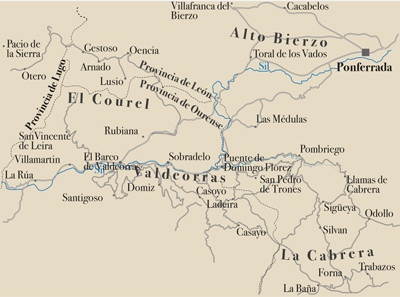 |
||
|
Slate deposits of El Caurel, Valdeorras and La Cabrera The area of El Caurel lies at the adjoining provinces of Lugo, Ourense and León. Valdeorras lies within the Ourense province and is the most important slate district of Spain. Within Valdeorras the most famous 'slate'-villages are Casayo, Castañero, Mormeau, Rozadais, Los Molinos, Domiz, Vianzola, Penedo and San Vincente. The region La Cabrera borders more or less south on Valdeorras and encloses the area of San Pedro de Trones, La Baña and Odollo. In this three slate districts one can notice a concentration of quarries, producing the main portion of the Spanish slate production. All three districts stretch over the Leon-West-Asturian-Zone and Galician-Castillian-Zone within the Iberian Mountains which is the western branch of the Hercynian orogen. Here the Hercynian orogeny deformed the paleozoic rocks.
Map showing the three slate districts
According to Perez-Estaun (1978), the geological setting of this slate districts is characterized by the occurrence of folded Cambrian to Silurian units which are partly overlaid by Cenozoic rocks. The area can be divided in N-S striking synclines and anticlines with a large scale folding as well as thrusts. The dominating structure is the 'Sinclinal del Trucha', which is northerly bordered by the 'Anticlinorio de la Sanabra'. Further structural elements are the 'Sinclinal de Peñalba' and the 'Anticlinorio de Caurel-Teleno' which create the western continuation of the recumbent folds of El Caurel. In the area of Alto Sil the Cambrian 'Candana-Herrería Formation' occurs, comprising a series of sandstones, slates and feldspar-rich sandstones. They are overlaid by a Cambrian-Ordovician transition zone which is called 'Serie de Los Cabos' and comprises alternating quartzites, slates and sandstones. Slate is mined within the Middle-Ordovician Formation 'Pizarra de Luarca' and in the area of Alto Sil it comprises relative monotonous black slates and a thickness between 2,625-3,281 ft. To the 'Serie de Los Cabos' no transition exist. In some cases about 246-984 ft. thick beds are observable and show volcanic-volcanoclastic intercalations which can irregularly contain cinnabarite. The thickness of the Formation 'Pizarra de Luarca' can regionally reach up to 1,640 ft. and one can observe transition zones to the 'Serie de Los Cabos', containing slates with sandy and quartzitic intercalations. Furthermore, within the bottom parts magnetic and chamositic intercalations can occur and they are also mined. In the area of Truchas the other important slate bearing 'Luarca Formation' shows a normal slaty development which can be up to 984 ft. thick. In the western part of the 'Sinclinal de Truchas' the 'Luarca Formation' begins with a 656 ft. thick series of slates with sandy intercalations. This series is overlaid by up to 492 ft. thick slates with sporadically intercalated carbonatic lenses. About 492 ft. thick minable roofing slates follow above which are again overlaid by 164 ft. thick non minable slates.
The 'Luarca Formation' is overlaid by the 'AgŁeira Formation' and in the area of Alto Sil it is characterized by an about 3,609 ft. thick sandy-pelitic interbedding and thus represents a typical turbidity sequence.
This transition zone is followed by an about 984 ft. thick series of light sandstone layers. The 'Luarca Formation' ends with a 66-164 ft. thick horizon of white quartzites which are called 'Cuarcitas de Vega'. The 'AgŁeira Formation' as well as the 'Luarca Formation' are the economically most important rock units for the mining of roofing slates. In addition, in some areas slate is mined within the 'Rozadais Formation' (Garcia-Guinea et al., 1997). During mapping the author could observe a moderately dipping, recumbent to overturned folding style. The folds generally face to NE and correspond to the fold type 1B-1C according to Ramsay's classification. Due to the competence contrast between slate and quartzite or sandstone, respectively, one can frequently see different fold styles directly next to each other: folds within less competent units are more isoclinale folds whereas in the competent quartzitic units the folds show a concentric style. In one quarry a cuspate-lobate fold could be observed. The deformation led to a spaced cleavage S1 in form of a fanning fracture cleavage which partly changes to a continuous foliation. The first cleavage is regionally overprinted by a crenulation foliation S2 with a changing intensity from hardly recognizable to a clear wrinkling of S1 and thus influences the bedding strength in different degree. In the microscopic picture one can see a asymmetric as well as symmetric development of S2. S2 shows a steeper dip than S1. |
